Kuppan T. Heat Exchanger Design Handbook
Подождите немного. Документ загружается.

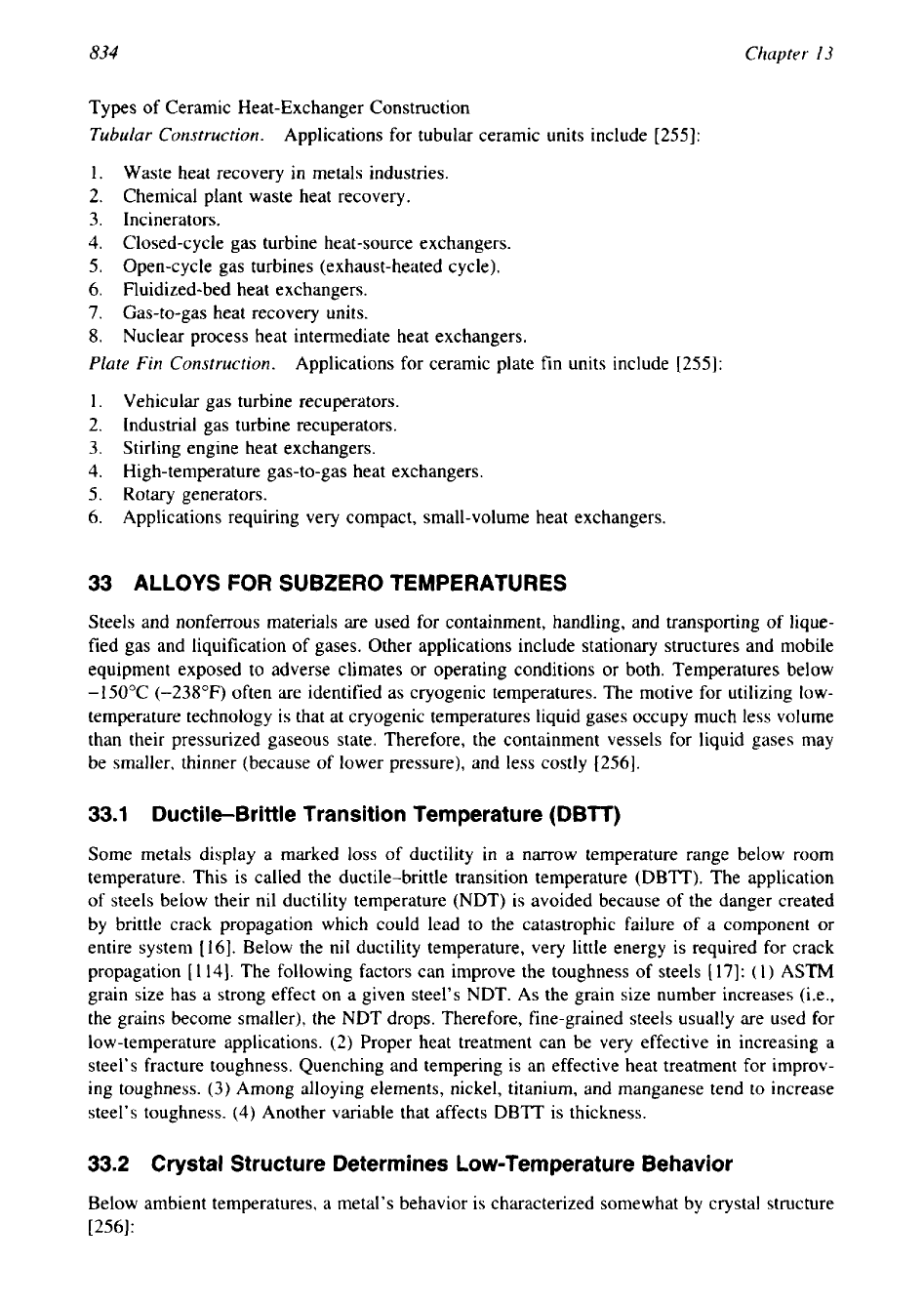
834
Chapter
13
Types of Ceramic Heat-Exchanger Construction
Tubular Construction.
Applications for tubular ceramic units include
[255]:
1,
Waste heat recovery in metals industries.
2.
Chemical plant waste heat recovery.
3.
Incinerators.
4.
Closed-cycle gas turbine heat-source exchangers.
5.
Open-cycle gas turbines (exhaust-heated cycle).
6.
Fluidized-bed heat exchangers.
7.
Gas-to-gas heat recovery units.
8.
Nuclear process heat intermediate heat exchangers.
Plate Fin Construction.
Applications for ceramic plate fin units include [255]:
1.
Vehicular gas turbine recuperators.
2.
Industrial gas turbine recuperators.
3.
Stirling engine heat exchangers.
4. High-temperature gas-to-gas heat exchangers,
5.
Rotary generators.
6.
Applications requiring very compact, small-volume heat exchangers.
33 ALLOYS
FOR
SUBZERO TEMPERATURES
Steels and nonferrous materials are used for containment, handling, and transporting
of
lique-
fied gas and liquification of gases. Other applications include stationary structures and mobile
equipment exposed
to
adverse climates or operating conditions or both. Temperatures below
-150°C
(-238°F)
often are identified as cryogenic temperatures. The motive for utilizing
low-
temperature technology is that at cryogenic temperatures liquid gases occupy much less volume
than their pressurized gaseous state. Therefore, the containment vessels for liquid gases may
be smaller, thinner (because of lower pressure), and less costly
[256].
33.1 Ductile-Brittle Transition Temperature
(DBTT)
Some metals display a marked
loss
of ductility in a narrow temperature range below room
temperature. This is called the ductile-brittle transition temperature (DBTT). The application
of
steels below their nil ductility temperature (NDT)
is
avoided because of the danger created
by brittle crack propagation which could lead
to
the catastrophic failure of a component or
entire system
[
161.
Below the nil ductility temperature, very little energy is required for crack
propagation
[
1
141. The following factors can improve the toughness of steels
[
171:
(1)
ASTM
grain size has a strong effect on a given steel’s NDT. As the grain size number increases (i.e.,
the grains become smaller), the NDT drops. Therefore, fine-grained steels usually are used for
low-temperature applications. (2) Proper heat treatment can be very effective in increasing a
steel’s fracture toughness. Quenching and tempering
is
an effective heat treatment for improv-
ing toughness.
(3)
Among alloying elements, nickel, titanium, and manganese tend
to
increase
steel’s toughness.
(4)
Another variable that affects DBTT is thickness.
33.2 Crystal Structure Determines Low-Temperature Behavior
Below ambient temperatures, a metal’s behavior is characterized somewhat by crystal structure
[256]:
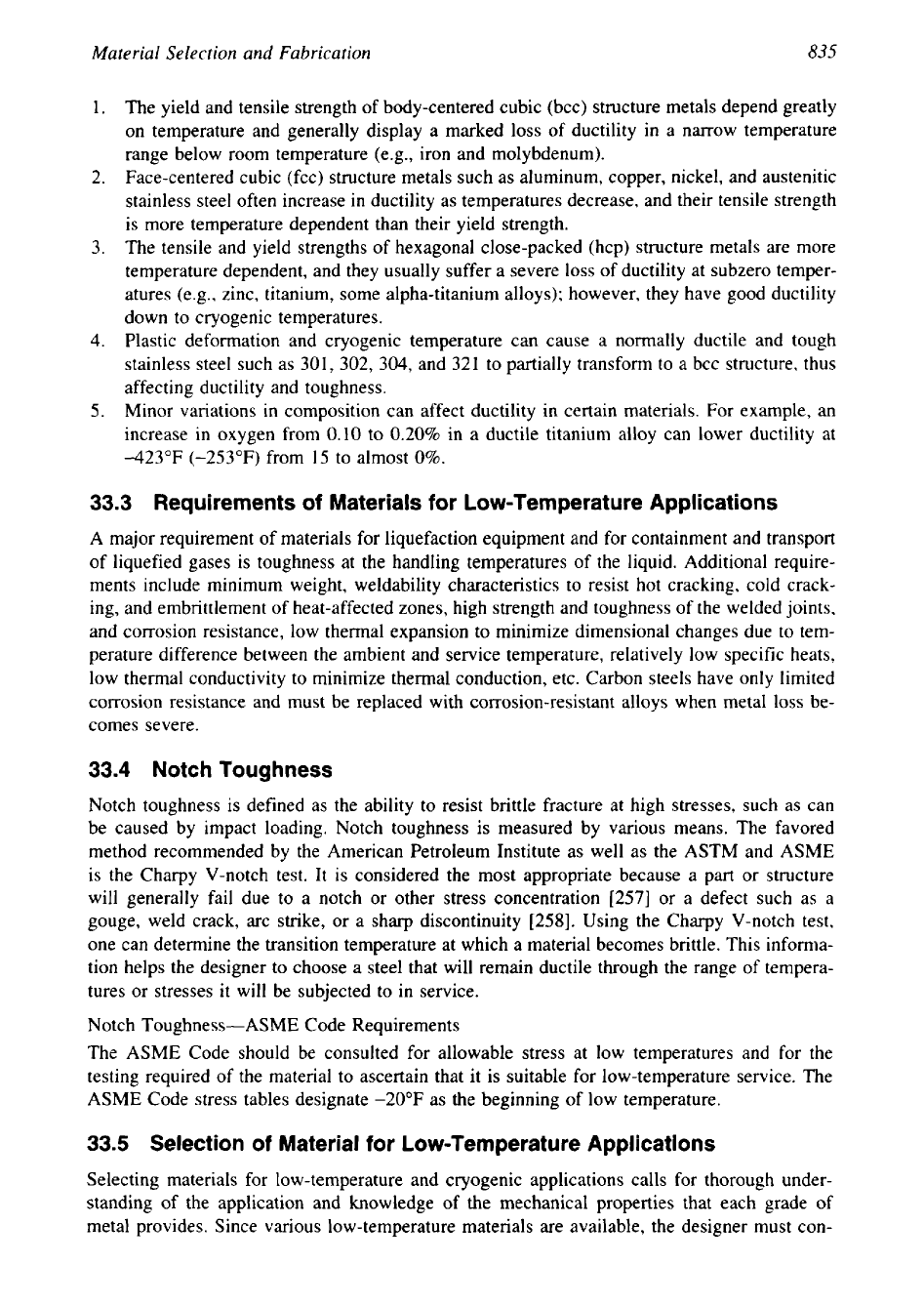
Material Selection and Fabrication
835
1.
The yield and tensile strength
of
body-centered cubic (bcc) structure metals depend greatly
on temperature and generally display a marked loss of ductility in a narrow temperature
range below room temperature (e.g., iron and molybdenum).
2.
Face-centered cubic (fcc) structure metals such as aluminum, copper, nickel, and austenitic
stainless steel often increase in ductility as temperatures decrease, and their tensile strength
is more temperature dependent than their yield strength.
3.
The tensile and yield strengths of hexagonal close-packed (hcp) structure metals are more
temperature dependent, and they usually suffer a severe loss of ductility at subzero temper-
atures (e.g., zinc, titanium, some alpha-titanium alloys); however, they have good ductility
down to cryogenic temperatures.
4.
Plastic deformation and cryogenic temperature can cause a normally ductile and tough
stainless steel such as
301,
302, 304, and 321 to partially transform to a bcc structure, thus
affecting ductility and toughness.
5.
Minor variations in composition can affect ductility in certain materials. For example, an
increase in oxygen from
0.10
to 0.20% in a ductile titanium alloy can lower ductility at
-423°F
(-253°F)
from
15
to almost
0%.
33.3
Requirements of Materials for Low-Temperature Applications
A major requirement of materials for liquefaction equipment and for containment and transport
of liquefied gases is toughness at the handling temperatures of the liquid. Additional require-
ments include minimum weight, weldability characteristics to resist hot cracking, cold crack-
ing, and embrittlement of heat-affected zones, high strength and toughness of the welded joints,
and corrosion resistance, low thermal expansion to minimize dimensional changes due to tem-
perature difference between the ambient and service temperature, relatively low specific heats,
low thermal conductivity to minimize thermal conduction, etc. Carbon steels have only limited
corrosion resistance and must be replaced with corrosion-resistant alloys when metal loss be-
comes severe.
33.4
Notch Toughness
Notch toughness is defined as the ability to resist brittle fracture at high stresses, such
as
can
be caused by impact loading. Notch toughness
is
measured by various means. The favored
method recommended by the American Petroleum Institute as well as the ASTM and ASME
is the Charpy V-notch test. It is considered the most appropriate because a part or structure
will generally fail due to a notch or other stress concentration
[257]
or a defect such as a
gouge, weld crack, arc strike, or a sharp discontinuity
[258].
Using the Charpy V-notch test,
one can determine the transition temperature at which
a
material becomes brittle. This informa-
tion helps the designer to choose a steel that will remain ductile through the range of tempera-
tures or stresses it will be subjected to in service.
Notch Toughness-ASME Code Requirements
The ASME Code should be consulted for allowable stress at low temperatures and for the
testing required of the material to ascertain that it is suitable for low-temperature service. The
ASME Code stress tables designate
-20°F
as the beginning of low temperature.
33.5
Selection of Material for Low-Temperature Applicatlons
Selecting materials for low-temperature and cryogenic applications calls for thorough under-
standing of the application and knowledge of the mechanical properties that each grade of
metal provides. Since various low-temperature materials are available, the designer must con-
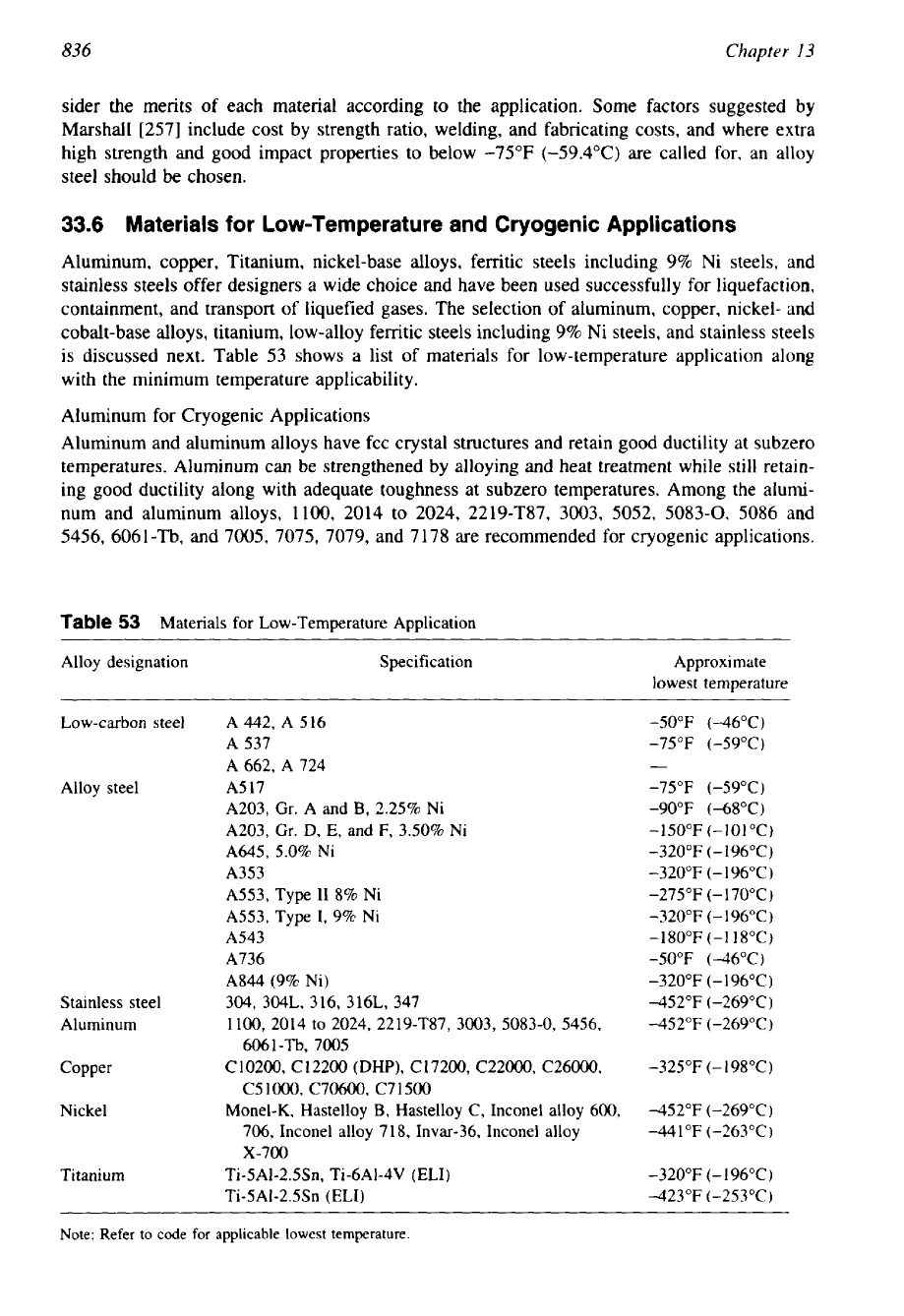
836
Chapter I3
sider the merits of each material according to the application. Some factors suggested
by
Marshal1 [257] include cost by strength ratio, welding, and fabricating costs, and where extra
high strength and good impact properties to below -75°F (-59.4"C) are called for, an alloy
steel should be chosen.
33.6
Materials for Low-Temperature and Cryogenic Applications
Aluminum, copper, Titanium, nickel-base alloys, ferritic steels including 9% Ni steels, and
stainless steels offer designers a wide choice and have been used successfully for liquefaction,
containment, and transport of liquefied gases. The selection of aluminum, copper, nickel- and
cobalt-base alloys, titanium, low-alloy ferritic steels including 9% Ni steels, and stainless steels
is discussed next. Table
53
shows a list
of
materials for low-temperature application along
with the minimum temperature applicability.
Aluminum for Cryogenic Applications
Aluminum and aluminum alloys have fcc crystal structures and retain good ductility at subzero
temperatures. Aluminum can be strengthened by alloying and heat treatment while still retain-
ing
good
ductility along with adequate toughness at subzero temperatures. Among the alumi-
num and aluminum alloys, 1100, 2014 to 2024, 2219-T87,
3003,
5052,
5083-0,
5086 and
5456, 6061-Tb, and 7005, 7075, 7079, and 7178 are recommended for cryogenic applications.
Table
53
Materials for Low-Temperature Application
Alloy designation Specification Approximate
lowest temperature
Low-carbon steel
A
442, A 516
-50°F (-46°C)
A 537
-75°F (-59°C)
A 662,
A
724
-
Alloy steel A5 17
-75°F (-59°C)
A203, Gr. A and
B,
2.25% Ni
-90°F (-68°C)
A203, Gr.
D,
E, and F, 3.50%
Ni
-150°F (-101°C)
A645,
5.0%
Ni
-320°F (-196°C)
A353
-320°F (-196°C)
A553, Type I1 8%
Ni
-275°F (-170°C)
A553, Type
1,
9%
Ni
-320°F (-196°C)
A543
-180°F
(-1
18°C)
A736
-50°F (-46°C)
A844 (9% Ni)
-320°F (-196°C)
Stainless steel
304, 304L, 316, 316L, 347
-452°F (-269°C)
Aluminurn
1100, 2014
to
2024, 2219-T87, 3003, 5083-0, 5456,
-452°F (-269°C)
6061-Tb, 7005
Copper
C10200, C12200 (DHP), C17200, C22000, C26000,
-325°F (-198°C)
C5 10o0, C70600, C7 1500
Nickel
Monel-K, Hastelloy
B,
Hastelloy C, Inconel alloy 600,
-452°F (-269°C)
706, Inconel alloy 718, Invar-36, Inconel alloy
-441°F (-263°C)
x-700
Titanium Ti-5A1-2.5Sn, Ti-6A1-4V (ELI)
-320°F
(-1
96°C)
Ti-5A1-2.5Sn
(ELI)
-423°F (-253°C)
Note: Refer
to
code
for
applicable lowest temperature.

Material Selection and Fabrication
83
7
The salient features of these alloys are discussed next. Before that, the factors that favor alumi-
num use in cryogenics are listed [259]:
1. Unlike other metals, aluminum has no ductile-to-brittle (DBT) transition regardless of the
direction of stress.
2. Inertness to cryogenics like methane, ethylene, argon, helium, neon,
O?,
N?,
H,.
3. Absence of corrosion at cryogenic temperatures; protective coatings are rarely necessary,
but the designer should be cautious of galvanic couple.
4. The tensile strength increases proportionately more than yield strength in the cryogenics,
so
heavily stressed tanks can warp more at cold than at room temperature without failing.
5.
Tear resistance, another measure
of
toughness, is the energy needed to propagate a crack.
Tear resistance of 5083-0 and its welds is as high at -196°C as it is at room temperature.
6. Emissivity and reflectivity: aluminum's low emissivity improves the effectiveness of insu-
lation systems [260].
7. Weldable and provide excellent mechanical properties in the as-welded condition.
3000
series:
Aluminum alloy 3003 is used in fabrication of brazed plate fin heat exchangers
and other equipment in gas liquefaction plants. It is available as tubing (including finned
tubing), pipe, sheet, and plate. It is readily joined by brazing or welding.
3003
meets the
requirements of the
ASME
Boiler and Pressure Vessel Code for working temperatures
upto -321°F (-196°C).
5000
series:
Alloys such as 5052, 5083, 5086, and 5456 exhibit a combination of properties
that make them popular for most applications. Their moderate strength, good toughness,
and good weldability have resulted in their selection for oceangoing tankers for carrying
oxygen, LNG, and other cryogenic gases, and for tank trailers, stationary storage contain-
ers, and processing equipment. For plate fin heat exchangers, 5083-0 is used.
6000
series:
Alloy 6061 offers the advantage listed for
5000
series alloys except that in the
as-welded condition its strength is low.
7000
series:
Alloys such as 7075, 7079, and 7178 display the highest strength of all aluminum
alloys. But they lose toughness below -320°F (-196°C). They are generally nonweldable
and found only in limited application. Two newer alloys, 7039 and X7007, show promise
for cryogenic service because they are readily welded and retain adequate toughness at all
temperatures [256].
Copper and Copper Alloys
Copper and copper alloys have fcc crystal structures similar to those of aluminum and retain
a high degree
of
ductility and toughness at subzero temperatures, down to -423°F (-253°C).
Copper alloys that might be considered for use at subzero temperatures are C10200 oxygen-
free copper, C12200
(DHP),
C17200, C22000, C26000, C51000, C70600, and C71500 [205].
The development of light-weight brazed aluminum heat exchangers for cryogenic applications
caused copper to be replaced by aluminum for many of these components.
Titanium and Titanium Alloys
Commercially pure titanium may be used for tubing and small-scale cryogenic applications
that involve only low stresses in service. For temperatures down to -320°F (-196"C), the
normal interstitial (NI) grade alloys Ti-5A1-2.5Sn and Ti-6A
1
-4V are suitable. Interstitial impu-
rities such as iron, oxygen, carbon, nitrogen, and hydrogen reduce the toughness of these alloys
at both room and subzero temperatures. For temperatures below -196"C, extra low interstitial
(ELI) grades of Ti-5A1-2.5Sn and Ti-6A1-4V are used [205]. The lower strength, all-alpha Ti-
5A1-2.5Sn
EL1
is used down to -423°F (-253"C), the temperature of liquid hydrogen. Titanium
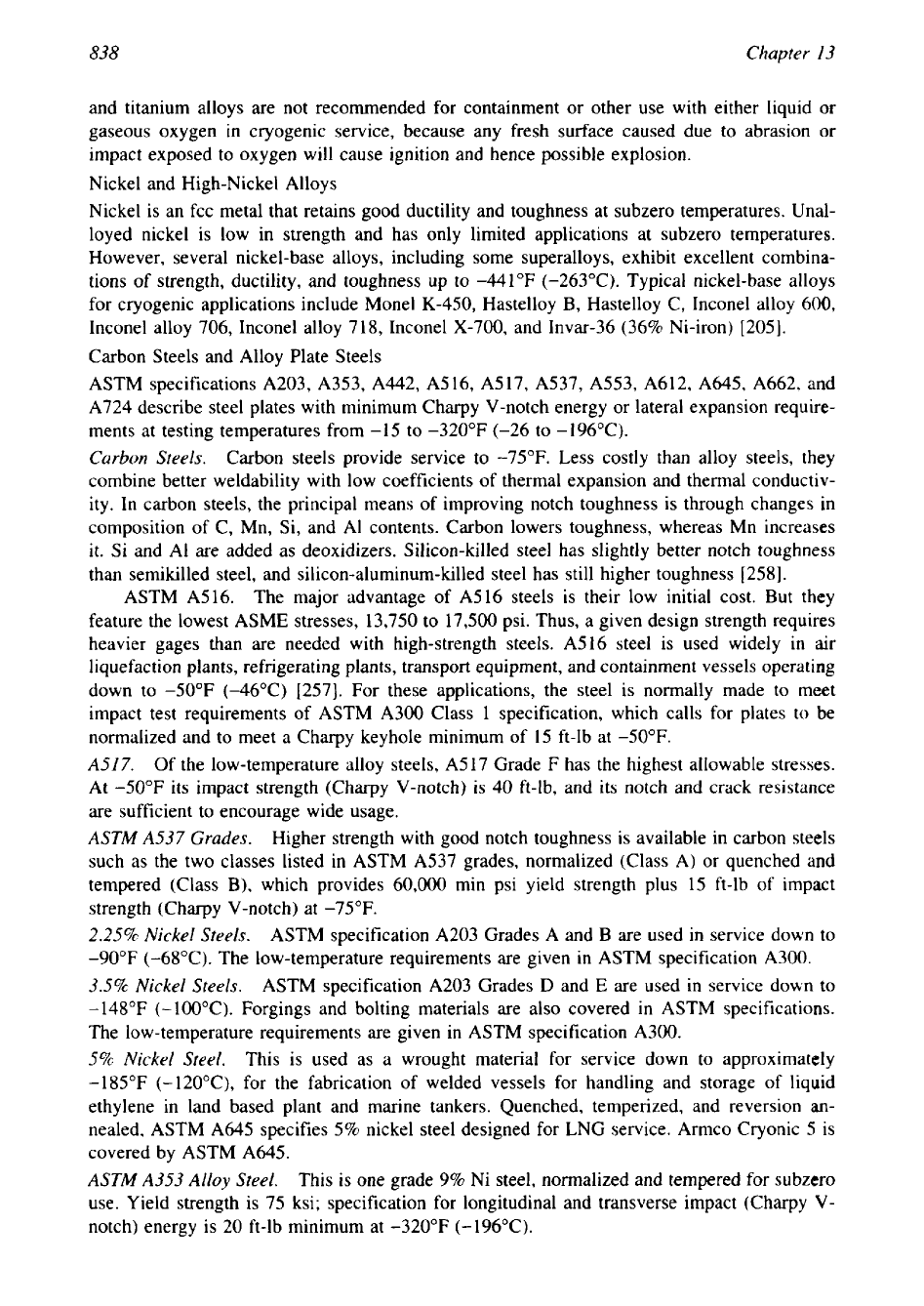
838
Chapter
13
and titanium alloys are not recommended for containment or other use with either liquid or
gaseous oxygen in cryogenic service, because any fresh surface caused due to abrasion or
impact exposed to oxygen will cause ignition and hence possible explosion.
Nickel and High-Nickel Alloys
Nickel is an fcc metal that retains good ductility and toughness at subzero temperatures. Unal-
loyed nickel is low in strength and has only limited applications at subzero temperatures.
However, several nickel-base alloys, including some superalloys, exhibit excellent combina-
tions of strength, ductility, and toughness up to
-44
1
"F
(-263°C). Typical nickel-base alloys
for cryogenic applications include Monel K-450, Hastelloy
B,
Hastelloy C, Inconel alloy
600,
Inconel alloy 706, Inconel alloy 718, Inconel X-700, and Invar-36 (36% Ni-iron) [205].
Carbon Steels and Alloy Plate Steels
ASTM specifications A203, A353, A442, A516, A517, A537, A553, A612, A645, A662, and
A724 describe steel plates with minimum Charpy V-notch energy or lateral expansion require-
ments at testing temperatures from -15 to -320°F (-26 to -196°C).
Carbon Steels.
Carbon steels provide service to -75°F. Less costly than alloy steels, they
combine better weldability with low coefficients of thermal expansion and thermal conductiv-
ity. In carbon steels, the principal means of improving notch toughness is through changes in
composition of C, Mn, Si, and A1 contents. Carbon lowers toughness, whereas Mn increases
it. Si and A1 are added as deoxidizers. Silicon-killed steel has slightly better notch toughness
than semikilled steel, and silicon-aluminum-killed steel has still higher toughness
[
2581.
ASTM A516.
The major advantage of A516 steels is their low initial cost. But they
feature the lowest ASME stresses, 13,750 to 17,500 psi. Thus, a given design strength requires
heavier gages than are needed with high-strength steels. A516 steel is used widely in air
liquefaction plants, refrigerating plants, transport equipment, and containment vessels operating
down to -50°F (-46°C) [257). For these applications, the steel is normally made to meet
impact test requirements of ASTM A300 Class 1 specification, which calls for plates
to
be
normalized and to meet a Charpy keyhole minimum of 15 ft-lb at -50°F.
A51
7.
Of the low-temperature alloy steels, A517 Grade F has the highest allowable stresses.
At -50°F its impact strength (Charpy V-notch) is
40
ft-lb, and its notch and crack resistance
are sufficient to encourage wide usage.
ASTM A537
Grades.
Higher strength with good notch toughness is available in carbon steels
such as the two classes listed in ASTM A537 grades, normalized (Class A) or quenched and
tempered (Class
B),
which provides 60,000 min psi yield strength plus 15 ft-lb of impact
strength (Charpy V-notch) at -75°F.
2.25%
Nickel Steels.
ASTM specification A203 Grades A and
B
are used in service down to
-90°F (-68°C). The low-temperature requirements are given in ASTM specification A300.
3.5%
Nickel Steels.
ASTM specification A203 Grades
D
and
E
are used in service down to
-148°F (-100°C). Forgings and bolting materials are also covered in ASTM specifications.
The low-temperature requirements are given in ASTM specification A300.
5%
Nickel Steel.
This is used as
a
wrought material for service down to approximately
-185°F (-12O"C), for the fabrication of welded vessels for handling and storage of liquid
ethylene in land based plant and marine tankers. Quenched, temperized, and reversion
an-
nealed, ASTM
A645
specifies 5% nickel steel designed for LNG service. Armco Cryonic
5
is
covered by ASTM A645.
ASTM A353
Alloy Steel.
This is one grade
9%
Ni steel, normalized and tempered for subzero
use. Yield strength is 75 ksi; specification for longitudinal and transverse impact (Charpy V-
notch) energy is 20 ft-lb minimum at -320°F (-196°C).
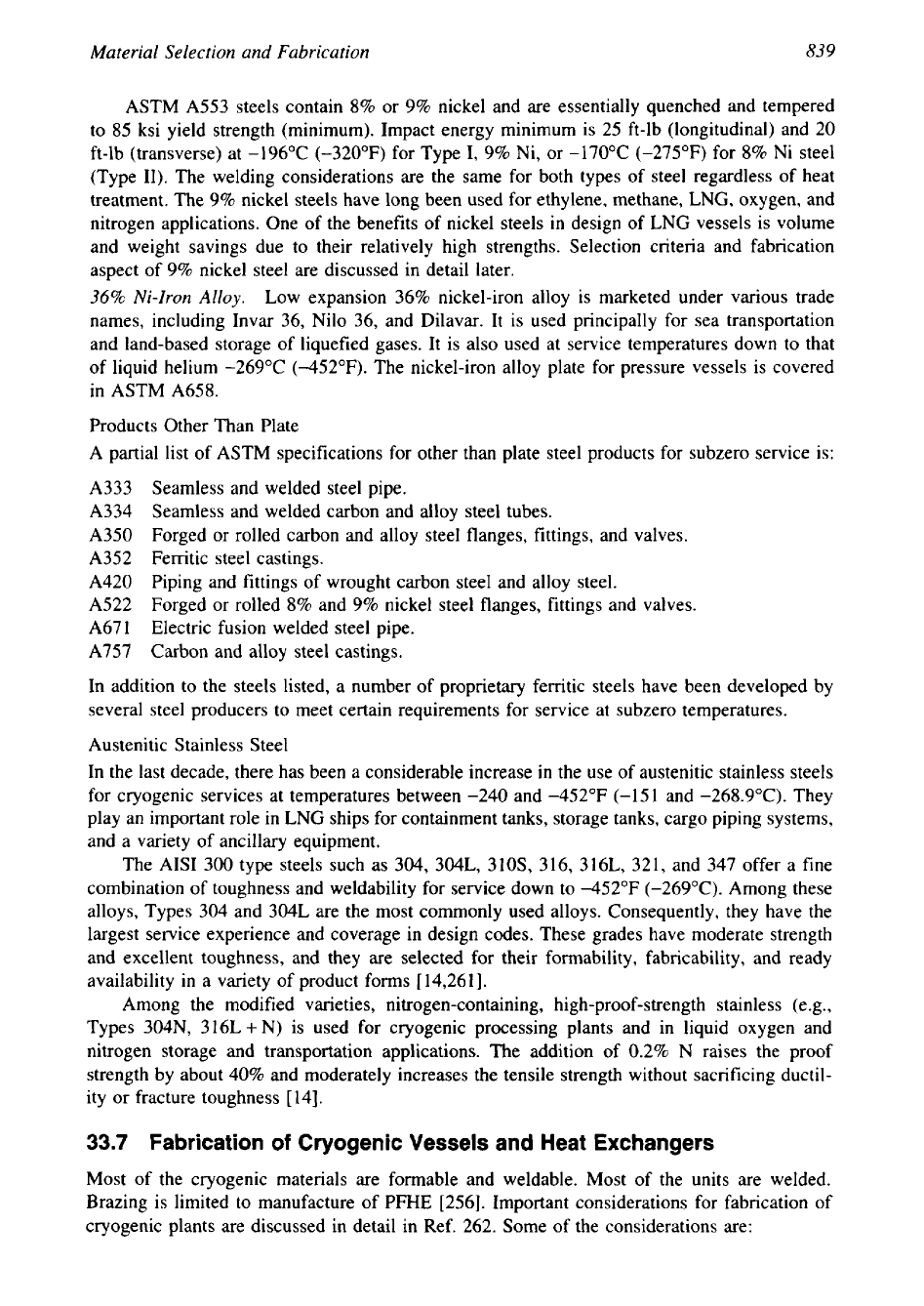
Material Selection and Fabrication
839
ASTM A553 steels contain
8%
or 9% nickel and are essentially quenched and tempered
to
85
ksi yield strength (minimum). Impact energy minimum is 25 ft-lb (longitudinal) and 20
ft-lb (transverse) at -196°C (-320°F) for Type I,
9%
Ni, or -170°C (-275°F) for
8%
Ni steel
(Type 11). The welding considerations are the same for both types of steel regardless of heat
treatment. The 9% nickel steels have long been used for ethylene, methane, LNG, oxygen, and
nitrogen applications. One of the benefits of nickel steels in design of LNG vessels is volume
and weight savings due to their relatively high strengths. Selection criteria and fabrication
aspect of 9% nickel steel are discussed in detail later.
36%
Ni-Iron Alloy.
Low expansion 36% nickel-iron alloy is marketed under various trade
names, including Invar 36, Nilo 36, and Dilavar. It is used principally for sea transportation
and land-based storage of liquefied gases. It is also used at service temperatures down to that
of liquid helium -269°C (-452°F). The nickel-iron alloy plate for pressure vessels is covered
in ASTM A658.
Products Other Than Plate
A partial list of ASTM specifications for other than plate steel products for subzero service is:
A333
Seamless and welded steel pipe.
A334
Seamless and welded carbon and alloy steel tubes.
A350
Forged or rolled carbon and alloy steel flanges, fittings, and valves.
A352
Ferritic steel castings.
A420
Piping and fittings of wrought carbon steel and alloy steel.
A522
Forged or rolled
8%
and 9% nickel steel flanges, fittings and valves.
A67 1
Electric fusion welded steel pipe.
A751
Carbon and alloy steel castings.
In addition
to
the steels listed, a number
of
proprietary ferritic steels have been developed by
several steel producers to meet certain requirements for service at subzero temperatures.
Austenitic Stainless Steel
In the last decade, there has been a considerable increase in the use of austenitic stainless steels
for cryogenic services at temperatures between -240 and -452°F (-151 and -268.9"C). They
play an important role in LNG ships for containment tanks, storage tanks, cargo piping systems,
and a variety
of
ancillary equipment.
The AISI 300 type steels such as 304, 304L,
310S,
316, 316L, 321, and 347 offer a fine
combination
of
toughness and weldability for service down to
-452°F
(-269°C). Among these
alloys, Types 304 and 304L are the most commonly used alloys. Consequently, they have the
largest service experience and coverage in design codes. These grades have moderate strength
and excellent toughness, and they are selected for their formability
,
fabricability, and ready
availability in a variety of product forms [14,261].
Among the modified varieties, nitrogen-containing, high-proof-strength stainless (e.g.,
Types 304N, 316L
+
N) is used for cryogenic processing plants and in liquid oxygen and
nitrogen storage and transportation applications. The addition of 0.2% N raises the proof
strength by about 40% and moderately increases the tensile strength without sacrificing ductil-
ity or fracture toughness
[
141.
33.7
Fabrication
of
Cryogenic Vessels and Heat Exchangers
Most of the cryogenic materials are formable and weldable. Most of the units are welded.
Brazing is limited to manufacture of
PFHE
[256]. Important considerations for fabrication of
cryogenic plants are discussed
in
detail in Ref. 262. Some
of
the considerations are:
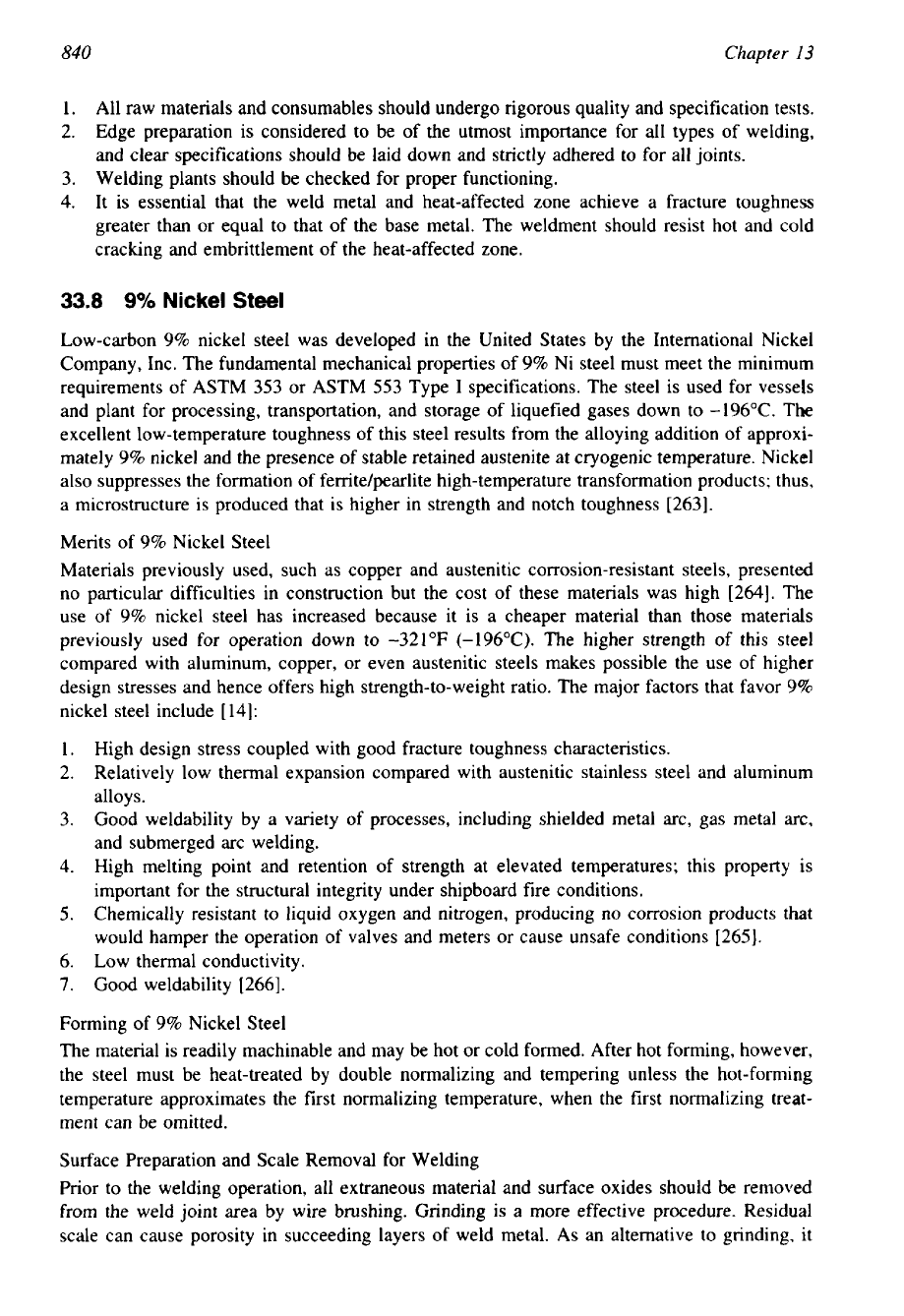
Chapter
I3
1.
All raw materials and consumables should undergo rigorous quality and specification tests.
2. Edge preparation is considered to be of the utmost importance for all types of welding,
and clear specifications should be laid down and strictly adhered
to
for all joints.
3. Welding plants should be checked for proper functioning.
4. It is essential that the weld metal and heat-affected zone achieve a fracture toughness
greater than or equal to that of the base metal. The weldment should resist hot and cold
cracking and embrittlement of the heat-affected zone.
33.8
9%
Nickel
Steel
Low-carbon 9% nickel steel was developed in the United States by the International Nickel
Company, Inc. The fundamental mechanical properties of 9% Ni steel must meet the minimum
requirements of ASTM 353 or ASTM 553 Type I specifications. The steel is used for vessels
and plant for processing, transportation, and storage of liquefied gases down to -196°C.
The
excellent low-temperature toughness of this steel results from the alloying addition of approxi-
mately 9% nickel and the presence of stable retained austenite at cryogenic temperature. Nickel
also suppresses the formation of ferritelpearlite high-temperature transformation products; thus,
a microstructure is produced that is higher in strength and notch toughness [263].
Merits of 9% Nickel Steel
Materials previously used, such as copper and austenitic corrosion-resistant steels, presented
no particular difficulties in construction but the cost of these materials was high [264]. The
use
of
9% nickel steel has increased because it is a cheaper material than those materials
previously used for operation down
to
-321°F (-196°C). The higher strength of this steel
compared with aluminum, copper, or even austenitic steels makes possible the use
of
higher
design stresses and hence offers high strength-to-weight ratio. The major factors that favor 9%
nickel steel include
[
141:
1.
High design stress coupled with good fracture toughness characteristics.
2.
Relatively low thermal expansion compared with austenitic stainless steel and aluminum
alloys.
3.
Good weldability by a variety of processes, including shielded metal arc, gas metal arc,
and submerged arc welding.
4.
High melting point and retention of strength at elevated temperatures; this property is
important for the structural integrity under shipboard fire conditions.
5.
Chemically resistant to liquid oxygen and nitrogen, producing no corrosion products that
would hamper the operation of valves and meters or cause unsafe conditions [265].
6. Low thermal conductivity.
7.
Good weldability [266].
Forming of 9% Nickel Steel
The material is readily machinable and may be hot or cold formed. After hot forming, however,
the steel must be heat-treated by double normalizing and tempering unless the hot-forming
temperature approximates the first normalizing temperature, when the first normalizing treat-
ment can be omitted.
Surface Preparation and Scale Removal for Welding
Prior to the welding operation, all extraneous material and surface oxides should be removed
from the weld joint area by wire brushing. Grinding is a more effective procedure. Residual
scale can cause porosity in succeeding layers of weld metal. As an alternative to grinding, it
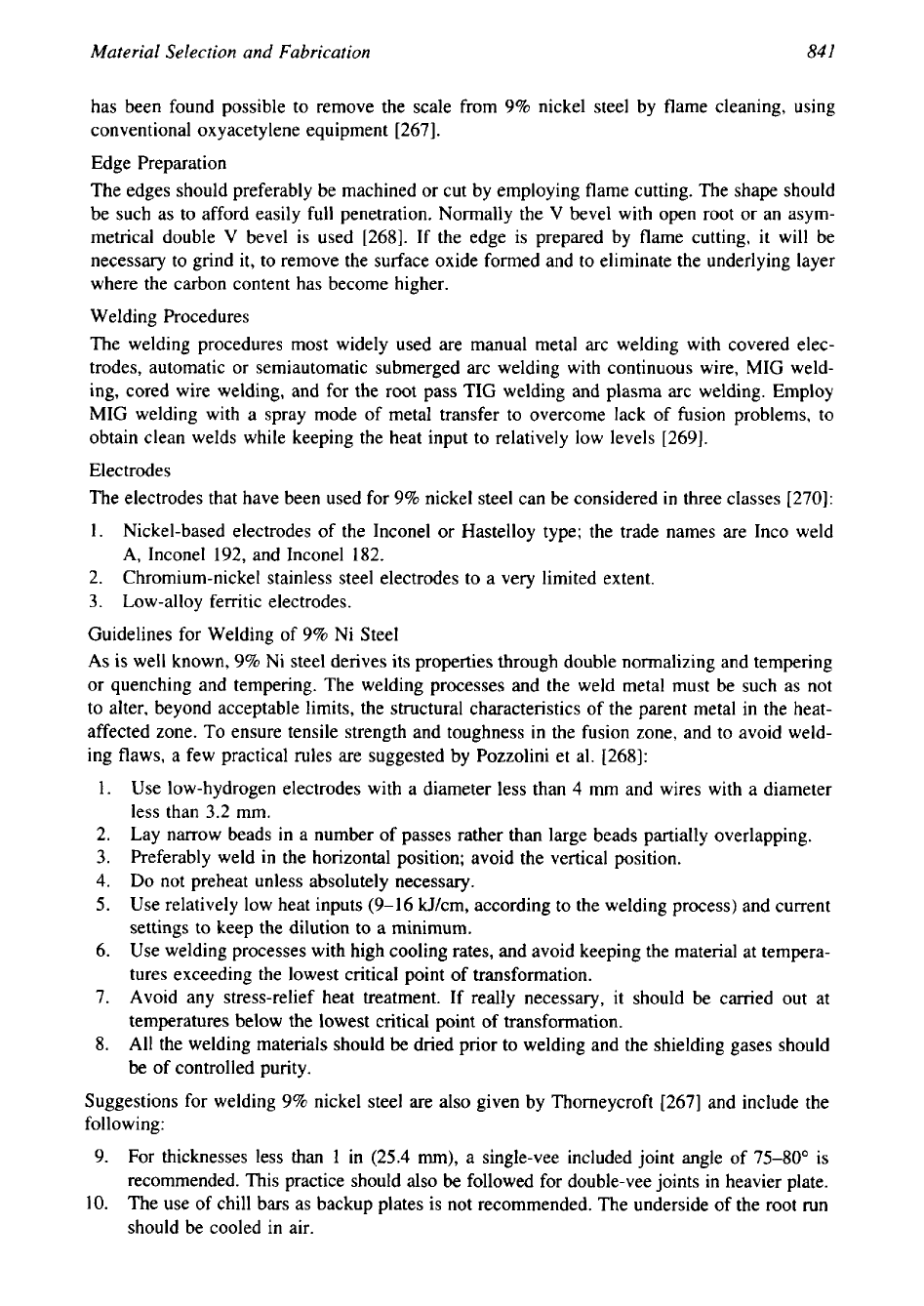
Material Selection and Fabrication
84
I
has been found possible to remove the scale from
9%
nickel steel by flame cleaning, using
conventional oxyacetylene equipment
[267].
Edge Preparation
The edges should preferably be machined or cut by employing flame cutting. The shape should
be such as to afford easily full penetration. Normally the
V
bevel with open root or an asym-
metrical double
V
bevel is used
[268].
If the edge is prepared by flame cutting, it will be
necessary to grind it, to remove the surface oxide formed and to eliminate the underlying layer
where the carbon content has become higher.
Welding Procedures
The welding procedures most widely used are manual metal arc welding with covered elec-
trodes, automatic or semiautomatic submerged arc welding with continuous wire, MIG weld-
ing, cored wire welding, and for the root pass TIG welding and plasma arc welding. Employ
MIG welding with a spray mode of metal transfer to overcome lack of fusion problems, to
obtain clean welds while keeping the heat input to relatively low levels
[269].
Electrodes
The electrodes that have been used for
9%
nickel steel can be considered in three classes
[270]:
1. Nickel-based electrodes of the Inconel or Hastelloy type; the trade names are Inco weld
A, Inconel
192,
and lnconel
182.
2.
Chromium-nickel stainless steel electrodes to a very limited extent.
3.
Low-alloy ferritic electrodes.
Guidelines for Welding of
9%
Ni Steel
As is well known,
9%
Ni steel derives its properties through double normalizing and tempering
or quenching and tempering. The welding processes and the weld metal must be such as not
to alter, beyond acceptable limits, the structural characteristics of the parent metal in the heat-
affected zone.
To
ensure tensile strength and toughness in the fusion zone, and to avoid weld-
ing flaws, a few practical rules are suggested by Pozzolini et al.
[268]:
1.
Use low-hydrogen electrodes with a diameter less than 4 mm and wires with a diameter
less than
3.2
mm.
2.
Lay narrow beads in a number of passes rather than large beads partially overlapping.
3.
Preferably weld in the horizontal position; avoid the vertical position.
4.
Do
not preheat unless absolutely necessary.
5.
Use relatively low heat inputs
(9-16
kJ/cm, according to the welding process) and current
settings to keep the dilution to a minimum.
6.
Use welding processes with high cooling rates, and avoid keeping the material at tempera-
tures exceeding the lowest critical point of transformation.
7.
Avoid any stress-relief heat treatment. If really necessary, it should be carried out at
temperatures below the lowest critical point
of
transformation.
8.
All the welding materials should be dried prior to welding and the shielding gases should
be
of controlled purity.
Suggestions for welding
9%
nickel steel are also given by Thorneycroft
[267]
and include the
following:
9.
For thicknesses less than
1
in
(25.4
mm),
a single-vee included joint angle of
75-80'
is
recommended. This practice should
also
be followed for double-vee joints in heavier plate.
10.
The use of chill bars as backup plates is not recommended. The underside of the root
run
should be cooled in air.
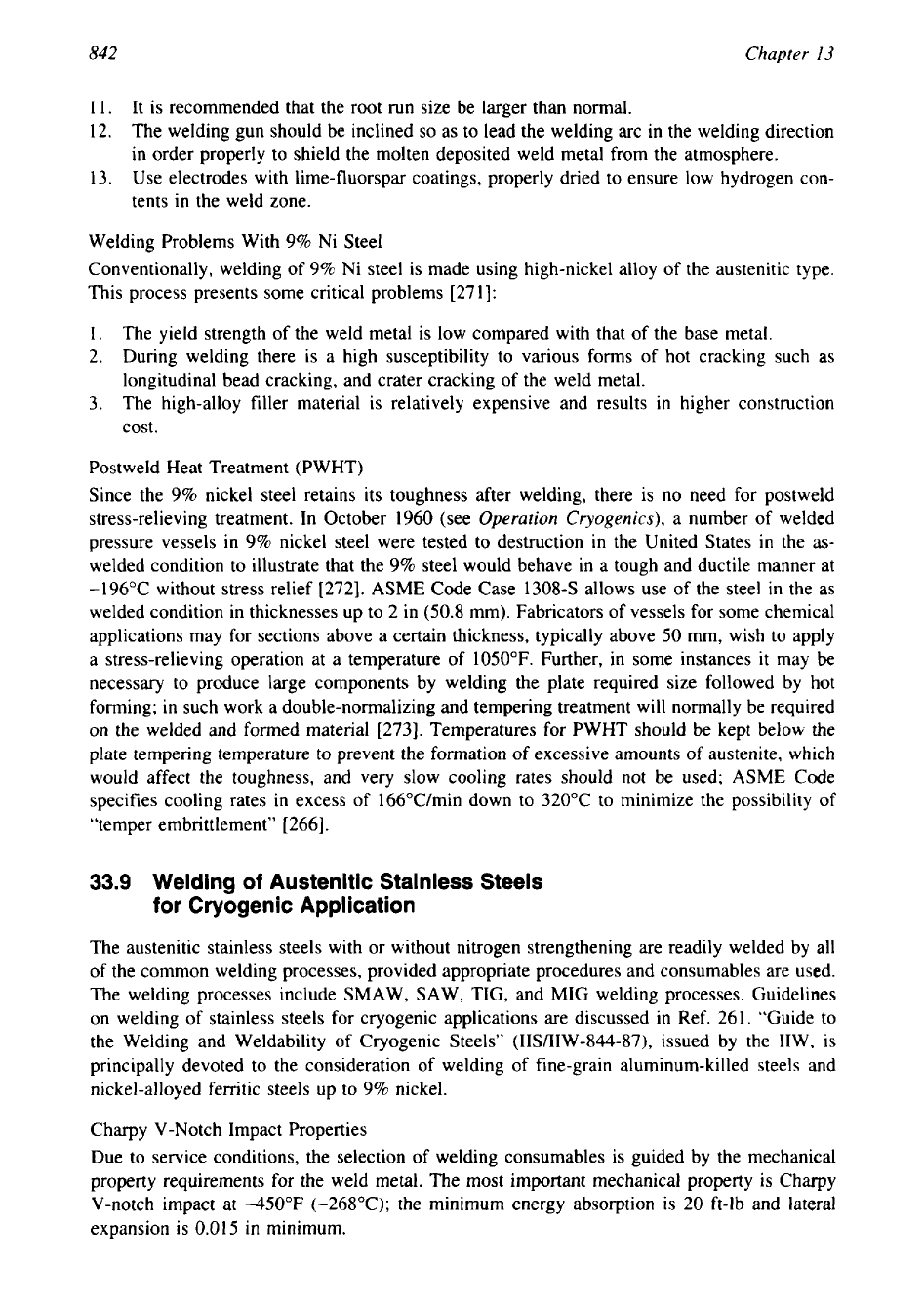
842
Chapter 13
11.
It is recommended that the root run size be larger than normal.
12.
The welding gun should be inclined
so
as to lead the welding arc in the welding direction
in
order properly to shield the molten deposited weld metal from the atmosphere.
13.
Use electrodes with lime-fluorspar coatings, properly dried to ensure low hydrogen con-
tents in the weld zone.
Welding Problems With 9% Ni Steel
Conventionally, welding of 9% Ni steel is made using high-nickel alloy of the austenitic type.
This process presents some critical problems [27
11:
1.
The yield strength of the weld metal is low compared with that of the base metal.
2. During welding there is a high susceptibility to various forms of hot cracking such
as
longitudinal bead cracking, and crater cracking of the weld metal.
3.
The high-alloy filler material is relatively expensive and results in higher construction
cost.
Postweld Heat Treatment (PWHT)
Since the 9% nickel steel retains its toughness after welding, there is no need for postweld
stress-relieving treatment. In October 1960 (see
Operation
Cryogenics),
a number of welded
pressure vessels in 9% nickel steel were tested to destruction in the United States
in
the
as-
welded condition to illustrate that the 9% steel would behave in a tough and ductile manner at
-196°C without stress relief [272]. ASME Code Case 1308-S allows use of the steel in the as
welded condition in thicknesses up to 2 in
(50.8
mm). Fabricators of vessels for some chemical
applications may for sections above a certain thickness, typically above
50
mm, wish to apply
a stress-relieving operation at a temperature of 1050°F. Further, in some instances it may be
necessary to produce large components by welding the plate required size followed by hot
forming; in such work a double-normalizing and tempering treatment will normally be required
on the welded and formed material [273]. Temperatures for PWHT should
be
kept below the
plate tempering temperature
to
prevent the formation
of
excessive amounts of austenite, which
would affect the toughness, and very slow cooling rates should not
be
used;
ASME
Code
specifies cooling rates in excess of 166”C/min down to 320°C to minimize the possibility of
“temper embrittlement” [266].
33.9
Welding
of
Austenitic Stainless Steels
for
Cryogenic Application
The austenitic stainless steels with or without nitrogen strengthening are readily welded by all
of the common welding processes, provided appropriate procedures and consumables are used.
The welding processes include SMAW, SAW, TIG, and MIG welding processes. Guidelines
on welding of stainless steels for cryogenic applications are discussed in Ref. 261. “Guide to
the Welding and Weldability of Cryogenic Steels” (IISAIW-844-87), issued by the IIW, is
principally devoted to the consideration of welding of fine-grain aluminum-killed steels and
nickel-alloyed ferritic steels up to
9%
nickel.
Charpy V-Notch Impact Properties
Due to service conditions, the selection of welding consumables is guided by the mechanical
property requirements for the weld metal. The most important mechanical property is Charpy
V-notch impact at
-450°F
(-268°C); the minimum energy absorption
is
20 ft-lb and lateral
expansion is
0.015
in
minimum.
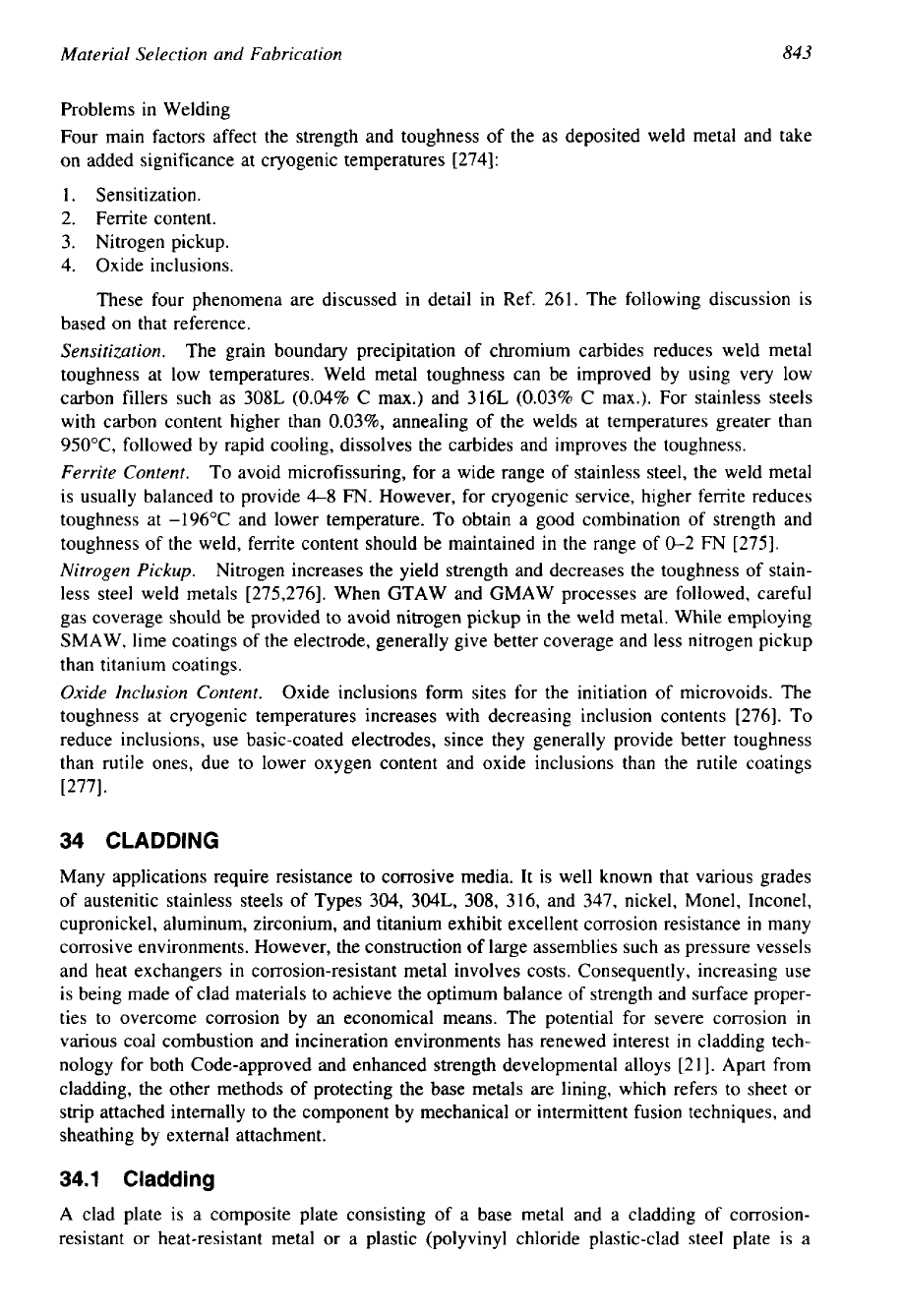
Material Selection and Fabrication
843
Problems in Welding
Four main factors affect the strength and toughness of the as deposited weld metal and take
on added significance at cryogenic temperatures [274]:
1. Sensitization.
2.
Ferrite content.
3. Nitrogen pickup.
4. Oxide inclusions.
These four phenomena are discussed in detail in Ref. 261. The following discussion is
based on that reference.
Sensitization.
The grain boundary precipitation
of
chromium carbides reduces weld metal
toughness at low temperatures. Weld metal toughness can be improved by using very low
carbon fillers such as 308L
(0.04%
C max.) and 316L (0.03% C max.). For stainless steels
with carbon content higher than 0.03%, annealing of the welds at temperatures greater than
950°C, followed by rapid cooling, dissolves the carbides and improves the toughness.
Ferrite Content.
To avoid microfissuring, for a wide range of stainless steel, the weld metal
is usually balanced to provide
4-8
FN.
However, for cryogenic service, higher ferrite reduces
toughness at -196°C and lower temperature.
To
obtain a good combination of strength and
toughness of the weld, ferrite content should be maintained in the range of 0-2
FN
[275].
Nitrogen Pickup.
Nitrogen increases the yield strength and decreases the toughness of stain-
less steel weld metals [275,276]. When GTAW and GMAW processes are followed, careful
gas coverage should be provided
to
avoid nitrogen pickup in the weld metal. While employing
SMAW, lime coatings of the electrode, generally give better coverage and less nitrogen pickup
than titanium coatings.
Oxide Inclusion Content.
Oxide inclusions form sites for the initiation of microvoids. The
toughness at cryogenic temperatures increases with decreasing inclusion contents [276].
To
reduce inclusions, use basic-coated electrodes, since they generally provide better toughness
than rutile ones, due to lower oxygen content and oxide inclusions than the rutile coatings
[
2771.
34
CLADDING
Many applications require resistance to corrosive media. It is well known that various grades
of austenitic stainless steels
of
Types 304, 304L,
308,
316, and 347, nickel, Monel, Inconel,
cupronickel, aluminum, zirconium, and titanium exhibit excellent corrosion resistance
in
many
corrosive environments. However, the construction
of
large assemblies such as pressure vessels
and heat exchangers in corrosion-resistant metal involves costs. Consequently, increasing use
is being made of clad materials to achieve the optimum balance of strength and surface proper-
ties to overcome corrosion by an economical means. The potential for severe corrosion
in
various coal combustion and incineration environments has renewed interest
in
cladding tech-
nology for both Code-approved and enhanced strength developmental alloys [21]. Apart from
cladding, the other methods of protecting the base metals are lining, which refers to sheet or
strip attached internally to the component by mechanical or intermittent fusion techniques, and
sheathing by external attachment.
34.1
Cladding
A clad plate is a composite plate consisting of a base metal and a cladding of corrosion-
resistant or heat-resistant metal or a plastic (polyvinyl chloride plastic-clad steel plate is a
